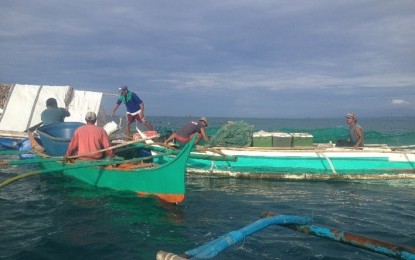
RED TIDE CONTAMINATION. Fishermen harvest cultured milkfish in the coastal waters of Guiuan, Eastern Samar in this undated photo. The Bureau of Fisheries and Aquatic Resources said the coastal areas of Eastern Visayas including its 12 bays have been contaminated with red tide toxin. (Photo courtesy of BFAR)
TACLOBAN CITY – Red tide toxin continues to thrive in 12 areas of Eastern Visayas, affecting the gathering and trading of shellfish in the region, the Bureau of Fisheries and Aquatic Resources (BFAR) reported on Monday.
In an advisory, BFAR confirmed that red tide toxins have affected coastal areas and several bays in the region since last year.
These are in Calubian in Leyte province; Guiuan, Eastern Samar; Cambatutay Bay in Tarangnan, Samar; Zumarraga, Samar; Daram, Samar; Leyte coastal areas, Leyte; Cancabato Bay in Tacloban City; and Matarinao Bay stretching across the towns of General MacArthur, Hernani, Quinapondan, and Salcedo in Eastern Samar; Biliran in Biliran province; Carigara Bay in Leyte; San Pedro Bay in Basey, Samar; and Ormoc Bay in the towns of Ormoc, Merida, and Albuera in Leyte.
BFAR Assistant Director for Operations Juan Albaladejo said what has been happening in the Pacific Ocean has a direct impact on the unpredictable weather condition in Eastern Visayas.
“This started in the third quarter of 2020 where a mild El Niño causes a long dry out season with occasional heavy rainfall event triggers the upwelling of inner shallow bays bringing up the sediments laden with red tide microorganism cysts and then use the organic load that comes with the sediments to start the bloom,” Albaladejo said in a statement on Monday.
BFAR said it issued a precautionary advisory to the public to refrain from gathering, selling, and eating all types of shellfish.
The fisheries bureau also banned the trading and consumption of Acetes sp. locally known as "alamang" harvested from said bays to avoid possible shellfish poisoning.
Local government units are advised to regulate the gathering, marketing, and transport of shellfish from the affected areas.
"Fish, squid, shrimp, and crab are safe to eat provided that they are fresh and washed thoroughly and internal organs such as gills and intestines are removed before cooking," the advisory added.
Red tide is a term used to describe a phenomenon where the water is discolored by high algal biomass or the concentration of algae. (PNA)
